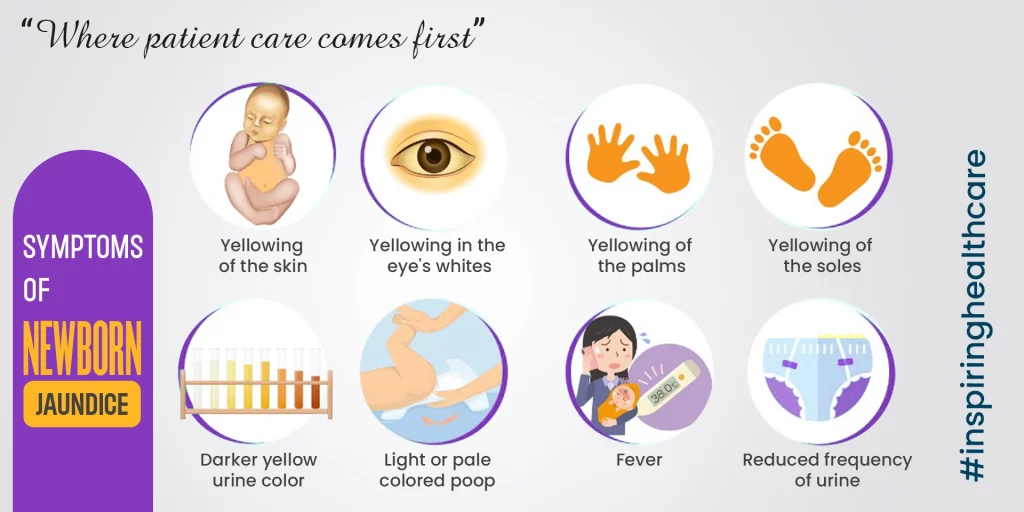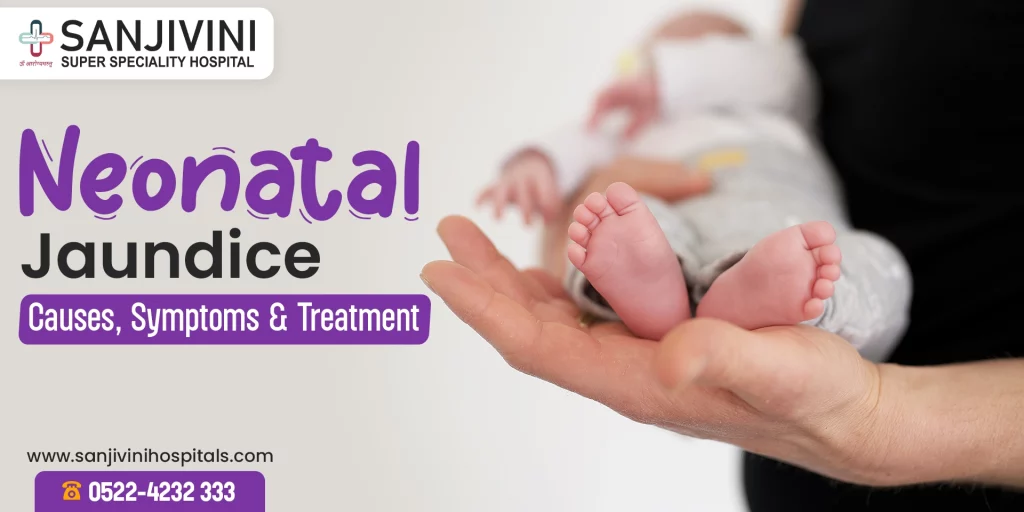Medically Reviewed by: Dr. Sonali Pandey– DCH, MBBS, DNB Paediatrics
Have you ever noticed a yellowish tint on your baby’s skin or eyes and wondered what it could be? That’s what we’re here to talk about – neonatal jaundice. It’s a common thing that happens to many newborns, and it can look a bit scary at first. But don’t worry! We’re going to break it down for you in simple terms.
As new parents, it’s natural to have questions and concerns, especially regarding your baby’s health. Neonatal jaundice might seem mysterious, but with a little understanding, you’ll feel more confident about what’s going on with your little one. So, let’s take a journey together to learn about neonatal jaundice – what causes it, what signs to look out for, and how it’s treated. By the end, you’ll be better equipped to care for your precious bundle of joy. Let’s get started!
What exactly is Neonatal Jaundice?
Neonatal jaundice is a common condition in newborns where the skin and eyes turn yellow. This happens because bilirubin, a yellow pigment from broken red blood cells, builds up in the baby’s blood. Since newborn livers aren’t fully developed, they struggle to get rid of bilirubin efficiently. Bilirubin is a natural byproduct of red blood cell breakdown, usually processed by the liver and expelled in stool. But in newborns, the immature liver can’t keep up, leading to jaundice.
Causes of Neonatal Jaundice
Neonatal jaundice has various causes, stemming from both physiological and pathological factors.
Physiologically, it occurs when fetal red blood cells break down, which happens frequently in newborns due to their high red blood cell count. Pathological causes can involve blood type differences, infections, or liver issues. Certain risk factors, such as prematurity, birth-related bruising, maternal infections, and specific medications, can increase the chances of jaundice in newborns.
The liver in newborns is still developing, making it less efficient at processing bilirubin and clearing it from the blood. This leads to higher bilirubin levels compared to adults. While most cases of neonatal jaundice resolve without treatment, elevated bilirubin levels can pose a risk of brain damage, especially when combined with other factors that increase the severity of jaundice.
Symptoms of Neonatal Jaundice
Neonatal jaundice is a common condition in newborns, characterized by yellowing of the skin and eyes, known as icterus. Typically, this yellowing starts on the face and scalp before spreading to the body. Other signs may include changes in feeding habits, lethargy or fussiness, dark urine, or pale stools. The severity of these symptoms varies depending on the cause and intensity of jaundice.

Physiological jaundice, a normal process, usually emerges two to three days after birth and typically resolves within a week without intervention. However, pathological jaundice, triggered by underlying issues like blood type mismatch, infections, or liver problems, often necessitates medical attention.
Risk factors
Major risk factors for jaundice, particularly severe jaundice that can cause complications, include:
- Premature birth: Babies born prematurely with low Birth weight babies especially those with breastfeeding difficulties or inadequate nutrition, are at higher risk due to dehydration or low-calorie intake.
- Blood type incompatibility: A clash between the mother’s and baby’s blood types can accelerate the destruction of the baby’s red blood cells, leading to higher bilirubin levels.
- Infection: Newborns may develop jaundice due to Bacterial or Viral Infections.
- Internal bleeding (hemorrhage): Bleeding inside the baby’s body can increase the breakdown of red blood cells, elevating bilirubin levels.
- Liver abnormalities: Conditions like liver malfunction, biliary atresia (blockage or scarring in the bile ducts), or enzyme deficiencies can disrupt bilirubin processing, resulting in jaundice.
- Additional factors: Studies suggest that babies of East Asian descent have a higher jaundice risk due to their race.
Severe jaundice, marked by elevated bilirubin levels, can lead to complications like acute bilirubin encephalopathy, which harms brain cells. Early treatment can mitigate lasting damage.
Diagnosis of Neonatal Jaundice
- Neonatal jaundice diagnosis involves:
- A thorough examination by healthcare providers.
- Visual inspection for signs of jaundice.
- Measurement of bilirubin levels through:
- Blood tests
- Non-invasive methods like transcutaneous bilirubinometry.
- Further investigation into underlying causes may be required if jaundice persists or worsens.
Treatment of Neonatal Jaundice
Treatment for neonatal jaundice typically includes the following methods:
- Phototherapy: This treatment exposes the baby to a specific type of light (not sunlight), which changes the bilirubin into water substances form, which can be easily excreted into feces and urine.
- Exchange transfusion: In rare cases where phototherapy isn’t effective or when bilirubin levels are dangerously high, an exchange transfusion may be necessary. This procedure involves replacing some of the baby’s blood with fresh, donated blood to lower bilirubin levels.
- Supportive care: Ensuring the newborn is well-hydrated and nourished is crucial. This may mean feeding the baby frequently, especially if they’re breastfed, to help eliminate bilirubin through bowel movements.
Prevention of Neonatal Jaundice
Preventing neonatal jaundice involves several steps:
- Antenatal care: Screening for risk factors during pregnancy helps identify conditions like blood type incompatibility or infections that could cause jaundice in newborns.
- Close monitoring in the first days of life: Keeping a close eye on newborns early on can help spot jaundice quickly, allowing for timely intervention.
- Ensuring proper feeding and hydration: Adequate feeding, especially for breastfed babies, prevents dehydration, which can worsen jaundice. Regular feedings help babies get rid of bilirubin through bowel movements.
- Educating mothers: Teaching expectant mothers about neonatal jaundice, its causes, and the importance of early recognition and intervention promotes preventive practices and prompt management.
These measures aim to lower the risk of neonatal jaundice and its complications. By identifying and addressing risk factors, as well as raising awareness and intervening early, severe neonatal jaundice can be minimized.
Also Read: Nutrition Tips for Picky Eaters: A Guide for Parents
When to see a doctor?
In most hospitals, it’s standard procedure to check newborns for jaundice before they leave. Usually, this happens between the third and seventh day after birth, when bilirubin levels are at their highest. If your baby is discharged within 72 hours of birth, schedule a follow-up appointment within two days to check for jaundice.
Here are signs that may indicate severe jaundice or complications from high bilirubin levels. Seek Consultation at Sanjivini Super Specialty Hospital Lucknow if:
- Your baby’s skin becomes yellower than before.
- Yellowing is visible on your baby’s abdomen, arms, palms, soles, or legs.
- The whites of your baby’s eyes take on a yellowish tint.
- Your baby appears unusually tired, sluggish, or hard to wake up.
- Your baby isn’t gaining weight or feeding well.
- Your baby cries with a high-pitched sound.
- The stool color is white and urine is dark yellow.
- Jaundice persists beyond 14 days of life.


Pingback: Neonatal Jaundice: Causes, Symptoms, and Treatm...